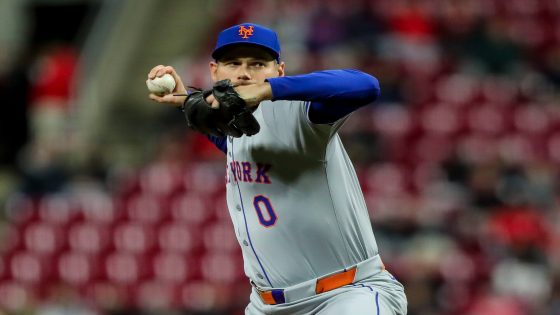“The good news is,” New York Mets right-hander Adam Ottavino said deep into a conversation about his evolution as a reliever, “I think a lot of the younger guys in the league don’t know what they’re doing with their pitches — whereas I feel like that’s my biggest strength, is knowing what to throw when.”
Knowing what to throw when has never been more important for Ottavino. He built his repertoire around a sweeping slider that was unique in the sport — then watched as just about every right-handed reliever with a lower arm slot adopted the pitch over the past two seasons. Ottavino went to work in the winter with the goal of adding back some velocity and adapting his mix, again, to the changing times.
Although Ottavino’s yet to see those extra miles per hour, he’s off to an excellent start. After allowing runs in each of his first two appearances, he’s retired 21 of his past 22 batters with the lone exception coming on an error. He has 14 strikeouts without issuing a walk, and his WHIP is below 0.500.
“It’s just trial and error,” he said of working through change at the major-league level, “but eventually you start to see the matrix a little bit because you’ve just been out there enough.”
Ottavino, at 38, is the third-oldest player in the majors and his 672 career games rank sixth among active players. He leads baseball in appearances since 2018.
I chatted with Ottavino about his strong start and the ways he’ll continue to adapt as the season progresses. The interview has been lightly edited, condensed and annotated.

When Adam Ottavino watched games with his dad as a kid, the question was always, ‘What would you throw here?’ (Scott Taetsch / USA Today)
Given the results so far, how do you feel about what you did in the offseason?
I haven’t thought about it yet, honestly. I don’t pass judgment yet. I’m learning still. I’m learning about what I have this year.
Some of my pitches are definitely different than they’ve been, but I’m learning how to make that work. I’ve gotten into good counts. That’s been the big thing.1 I won’t be in these counts all the time, and I’ll learn a lot more then.
1 Ottavino has faced 30 batters this year. He’s yet to go 2-0 on any of them, and he’s gotten to two strikes before two balls 87 percent of the time.
“Of all the guys on our staff, he’s in advantage counts almost every single at-bat,” pitching coach Jeremy Hefner said. “It’s as simple as that. If you’re getting ahead of guys, you’re going to have success.”
What’s been working differently for you?
My slider has been really slow and really big with a little more drop on it than I had in the past. It’s more slurvy now. Instead of trying to force it back the other way, I’ve kind of just let it be a little bit. It’s playing well. It’s actually playing better than I thought it would. The slowness is helping me because it’s making my fastball look faster. The contact on it, outside of the one home run I gave up, which I thought was a great swing, has been pretty lousy.2 That’s encouraging.
2 The average exit velocity against Ottavino’s slider has been 78 mph.
Did that just kind of happen with the slider?
In spring I was trying to get it over 80 mph. That was really important in my mind. I was just trying to get back to what I thought was working in ’22 because that seemed to be a big factor. My slider wasn’t as sharp last year, so I was trying to recreate that. In the course of doing that, I had a few games where it happened and then a few where no matter what I was doing, it was still 77 or 78. But I’d look at the metrics after the game and notice that the break was bigger.
People are taking it, and when they’re swinging at it, they’re swinging a little weird. So let’s not be so desperate to get to some artificial number that I’m not sure matters yet. Sure, I’d like to throw it harder at times to generate more chase. In terms of in the zone, this might be a better pitch. We’re going to have to find out.
You used the cutter a lot in the first half of last year and went away from it in the second half. How does that feel as a pitch you’re sprinkling in?
Coming into last year, I really did think it was the answer for me for lefties. What I found out over time is that overexposure to that pitch was a big issue. When I threw more than two of them to a batter, the contact numbers just got really ugly. Also, I was using it in ways that were non-beneficial — times I had to throw it in the zone.3
If I keep it super flat and throw it high, it’s decent in the zone. But if it has depth to it, it’s really bad in the zone. The depth pitch has to be for chase. So I have to separate those as two different options in my mind and use them as such.
If I go to it with two strikes, it’s more for chase. Early in the count, keep it flat and up in the zone. And I’m not going to throw three or four of them. It’s still a pitch in my arsenal, but I’m happy right now because I don’t have any particular pitch that’s driving the bus. I’m just going to mix it up as much as I can against lefties.
3 Against lefties, Ottavino threw his cutter 38 percent of the time over the first three months of the 2023 season. In the last three months, he threw it 14 percent of the time against lefties.
Is it difficult to keep those pitches distinct?
There’s a grip change. On the flat one, I keep my fingers pretty spread wide, so when I release it I’m still trying to throw through it like a fastball. And when I want to throw it on the plate, I’ve just been getting the fingers together, more like a slider grip, and think the same thing but over the ball a little bit more. That’s giving me similar speed but more drop.
Because I threw so many last year, I’ve developed a little bit of a feel. It’s hard. But I threw a couple hundred of them last year and that allowed me to start to understand the nuance there. The previous offseason I didn’t get it. It took a little while to figure it out.
You said earlier you’re still learning what you have. When do you have a better idea?
Like June 1. We’re still gathering a lot of data right now across the league — what’s working in general, what’s not working, how the ball is behaving, how your stuff is going to play. You’re trying to figure it out as fast as you can.
For me, I’ve noticed that by June 1 I usually can pivot and have a really intelligent, informed reason to do so. If I do it earlier, it’s probably more of a hunch. I’m happy that the results have been pretty good so far because that allows me to stay the course with what I’m doing and to really test-drive that. If I have to pivot, I’ll have a real reason behind it.
What do you look at around the league? Last year we talked about how sliders were less effective.
Everything. We try to look at all the trends. The sweeper last year across the league, with more people throwing it became less effective for chase. Then you saw guys throwing two different types of slider, one to get chase and one to throw in the zone. That’s kind of the idea behind my downward cutter, whereas my sweeper is so slow it’s not going to get a lot of chase.
With my arsenal, it’s tough because everything is so sideways. I’m trying to get something to go downward in that area when I need to get chase. I don’t have a big overhand curveball or splitter. My arm slot just won’t do it.
I have the luxury of having been around enough where now I know I’m capable of making adjustments on the fly and I just have to stay aware of what’s happening around the league and how it applies to me. There are so many games played all around that clues start to form a little bit, usually by the end of April and you see how it progresses through May and then you’re like, ‘OK, this is the game this year.’ There are subtle changes every year.
Last year we talked about how unique your arsenal had been. Now, more and more guys use that. Are there guys you look at who look like you that you can steal from or learn from?
I don’t think it’s me anymore. I think it’s the nature of the pitch design era. It’s derivative in a way. Everybody with a certain arm slot that’s not super high up is going to end up throwing the same types of pitches: You’re going to throw sinkers, you’re going to throw cutters, you’re going to throw some sort of changeup or split, some sort of sweeping slider, and if you have a four-seam, it’s not going to have great movement but because your arm slot’s low it’ll play at times. That’s where I’m at, that’s where Grant Hartwig is at, that’s where Reed Garrett is at with much more octane. That’s where Jorge López is going to be. Everybody ends up in that spot.
And if you have a higher arm slot, you end up with a carry four-seamer and some type of really ‘depthy’ breaking ball. Because of the revolution of the pitch design era and matching pitches to arm slots, that’s why it ends up this way.
When did you figure that out?
Honestly, it’s the thing I focused on most growing up. As a kid with my dad, when we watched the games, it was, ‘What would you throw here?’ The concept was always any pitch, any time to any hitter, any count. You have to be able to throw everything. That’s the approach I started building on from a very young age. I threw breaking balls from a very young age.
I always pitched backward. In college, the scouts used to get mad at me because I threw so many offspeed pitches. It’s always been there, but once you get to the big leagues it’s a whole new experience of what works and what doesn’t work.
Just being obsessed with the game and pitching enough games, which I’ve been healthy enough to do, you start to follow the trends of your own game. I remember when I stopped throwing sinkers down and away to lefties because it’s not working. Even though they’re telling me this is a good pitch, over enough sample it wasn’t giving me the results I need.
(Top photo of Adam Ottavino: Katie Stratman / USA Today)



